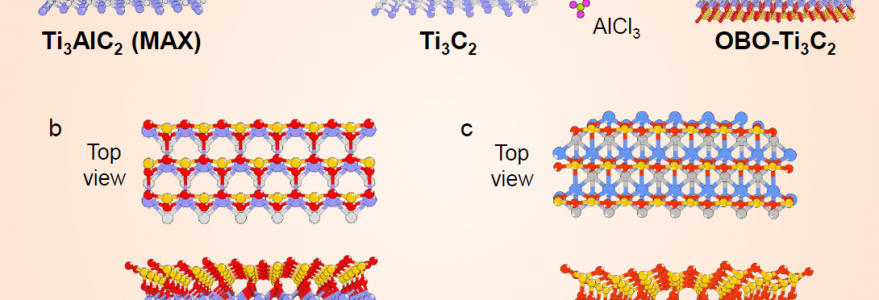Scientists from the Faculty of Chemistry and the Biological and Chemical Research Centre at the UW investigated the synthesis and characterisation of 2D materials used for rapid storage of large amounts of electrical energy. Their finds were published in “Nature Materials”.
The international team of researchers from, among others, the University of Warsaw, Dresden University of Technology (Technische Universität Dresden), and Brno University of Technology (Vysoké učení technické v Brně), described the synthesis of MXens with triatomic-layer borate polyanion terminations (OBO terminations) through a flux-assisted eutectic molten etching approach. The synthetised and characterised 2D material is intended for rapid storage of large amounts of electrical energy.
During the three-year-long joint project, a method was developed for synthesising advanced MXenes, which efficiently store electrical energy, featuring an ordered 2-dimensional structure separated by borates. These new materials exhibit significantly better charge transport and storage properties compared to existing materials.
The structural studies and high-resolution compositional analyses conducted at the University of Warsaw enabled the positioning of individual atoms within the layers as well as allowed for the optimisation of synthesis and contributed to explaining the charge storage capabilities of the produced MXenes.
The research has been conducted by three scientists from the University of Warsaw: Prof. Mikołaj Donten from the Faculty of Chemistry, and Dr Kamil Sobczak and Prof. Ehrenfried Zschech from the Biological and Chemical Centre.
“We intend to investigate crystalline polymers for use in aqueous zinc batteries. We predict that such batteries will exhibit high cycling stability and retain their capacity even after several thousand charge and discharge cycles,” Dr Kamil Sobczak said.
The study has been carried out within the international consortium The M-ERA.NET, which is an EU-funded network in materials science, technology and innovation. The network comprises 49 partners from 35 countries.
The results of the research into the synthesis and characterisaton of the 2D MXens are published in Nature Materials.
Publication details
Dongqi Li, Wenhao Zheng, Sai Manoj Gali, Kamil Sobczak, Michal Horák, Josef Polčák, Nikolaj Lopatik, Zichao Li, Jiaxu Zhang, Davood Sabaghi, Shengqiang Zhou, Paweł P. Michałowski, Ehrenfried Zschech, Eike Brunner, Mikołaj Donten, Tomáš Šikola, Mischa Bonn, Hai I. Wang, David Beljonne, Minghao Yu & Xinliang Feng, 2024, MXenes with ordered triatomic-layer borate polyanion terminations, Nature Materials, https://doi.org/10.1038/s41563-024-01911-2




